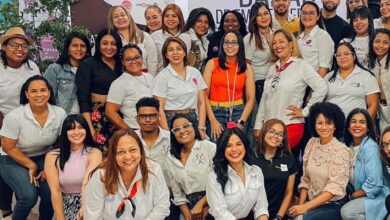Why women’s entrepreneurship is booming post-pandemic

Half of all businesses started in the pandemic era were founded by a woman, compared to just 29% in 2019. A business incorporation surge and the role women have played reversed decades-long trends during COVID-19 disruptions.
“The pandemic just opened up a huge window for people to be able to do their thing, no holds barred,” said Omi Bell, the DC-based founder and CEO of Black Girl Ventures, which connects women of color to capital and other business resources. “It shifted how we think everything has to happen.”
The COVID new-business boom was welcome news, after decades of entrepreneurial decline in the United States. Nearly four years after a pandemic shook economies and identities, rates of new business incorporation remain elevated. Women are the biggest contributor to the difference between 2019 and 2023 business rates. Black women in particular are disproportionately incorporating new firms, as Technical.ly has reported.
Not all businesses are created the same, of course. Though incorporating a business has become more representative of American demographics, most of these businesses remain small, with little revenues and no employees. These contribute heavily to the $1.3 trillion freelancer economy — 27% of new firms surveyed by payroll provider Gusto were launched as a side hustle.
Lots more women are entrepreneurs, then, but they’re more likely to be sole proprietors or supplementing their income. Think of the freelance graphic designers, independent hairdressers and ecommerce drop-shippers. Many contribute to the surprising detail that the average self-employed American earns less than her traditionally employed peer. The door of entrepreneurship may have opened, but all the action is in a room upstairs.
This gets us to two questions: What caused the women entrepreneurial boom, and can a rotten cause — including traditional workplaces failing those women — produce an economic good?
Why has women’s entrepreneurship increased, and will it continue?
Harvard University professor Claudia Goldin won last month the coveted Nobel Prize in Economics for her exhaustive work piecing together patchy historical data on American women in the workforce. Among her findings include that plenty of married women in 1890 were entrepreneurs managing family businesses, but they identified as “housewives” to data collectors — Goldin’s work corrected that year’s women’s employment rate fivefold to 12.5%.
She also contributed to disentangling how much of the women’s pay gap remains due to workplace discrimination rather than the growth of “greedy jobs.” That’s her term from a 2021 book describing high-paying corporate jobs with long hours that don’t fit with stubborn household gender patterns for parenting. Goldin’s research argues that today gender income inequality has less to do with outright gender discrimination than with women opting out of jobs that demand long hours — say, corporate attorney — because they are more likely to take on greater domestic responsibilities than their male partners. The gender pay gap, she says, is now more effectively fought at home between partners than at work.
“[Women] realized for a variety of reasons that the traditional workforce or private sector wasn’t working for them, and they wanted to bet on themselves and build something,” said Jamie Sears , who has specialized in women entrepreneurs as co-head of impact at wealth management giant UBS.
Enter evolving expectations for entrepreneurship. Startup hustle is in retreat, and the boom of women founders is due in part to high-powered women offering an ultimatum: Boost workplace flexibility or I’ll start my own thing. Companies called the bluff, and enough women walked that it’s appearing in the data.
Many workplaces were unfriendly, or at least indifferent, to family life before the pandemic, why the boom now? Many point to the uprooting of so many habits during pandemic lockdowns, which no doubt contributed. We at Technical.ly looked further: With funding from UBS and Sears, we published this fall “The Inclusion Edge,” an analysis of a decade of inclusive entrepreneurship programs and investments. Economists will tease out various influences for years, but those Technical.ly interviewed agreed that a foundation was laid of resources, programs and networks. Millions of Americans, especially women who disproportionately carry a higher domestic burden than male partners, looked for a change during the pandemic, and they were familiar enough with options that they took the leap.
Labor demands might shift, but it seems likely entrepreneurial activity as a tool for not just wealth creation, but lifestyle advancement, will last for years to come.
“Women have learned they can do this,” Sears said.
What can we learn from this moment?
Before the Industrial Revolution, working-class Americans often lived in double-income households. Women were paid by the textile produced, rather than the hours worked, so they pieced this around other domestic responsibilities. Grueling, but at least independent.
We may be back there again. Entrepreneurship can be a path for anyone to create a life they want, most prominently women. Network building, capital readiness and storytelling to encourage more are tools that proved effective, as Sears has bet on with her own investments. More business starts is good, but funders like Sears and providers like Bell are focusing on helping new founders grow their businesses.
The worry is if this evades the key issue: workplaces that are both economically vibrant and supportive of families. By most accounts, programs to support women entrepreneurship in the United States have succeeded. A result is that employers will compete for talent not just from other firms but from independent practice, as Technical.ly has reported.
It’s important to note that the women founder boom is unequal geographically — Washington DC has 4,754 women-owned businesses per 100,000 people, the country’s highest total, with Maryland not far behind. In contrast, Pennsylvania has just 2,809 and Delaware even fewer, giving them among the lowest totals in the United States, according to an analysis of SBA data.
Inflexible workplaces may be a disappointing motive for an entrepreneurial renaissance, but the result is still what we want to see. The work now is on widening the boom, and strengthening the businesses.
As Bell said: “The world needs what women are building.”
Join the conversation!
Find news, events, jobs and people who share your interests on Technical.ly’s open community Slack
Technically Media



